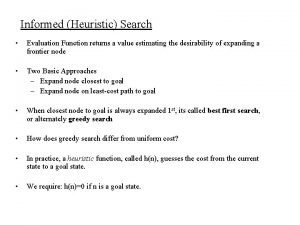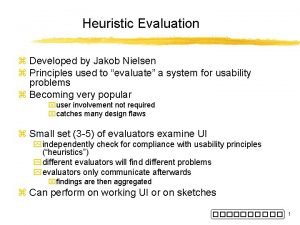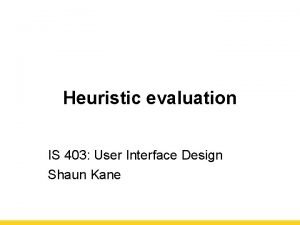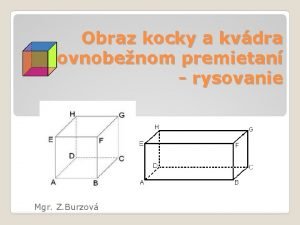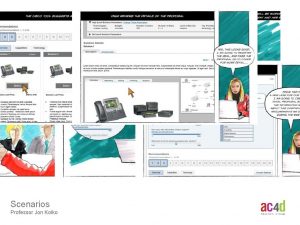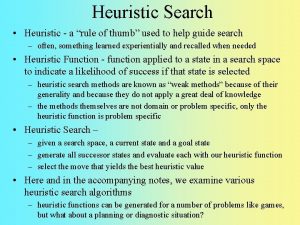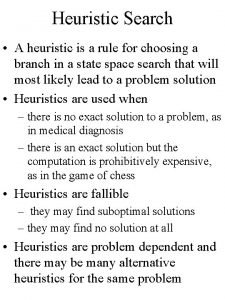Heuristic Evaluation Jon Kolko Professor Austin Center for





















- Slides: 21

Heuristic Evaluation Jon Kolko Professor, Austin Center for Design

Heuristic Evaluation Compare an interface to an established list of heuristics – best practices – to identify usability problems.

Heuristic Evaluation Compare an interface to an established list of heuristics – best practices – to identify usability problems. A HEURISTIC/ 1. 2. 3. 4. 5. Is defined by a person or a group of people Is deemed to be a “good principle” to follow Is recognized by others as a “good principle” Is not a hard/fast rule Is not always right


Heuristic Evaluation: The Basics 1. 2. 3. 4. On your own, compare an interface to a list of heuristics Determine which heuristics are violated by the interface As a group, combine these lists into a more exhaustive listing Write a report and include redesign suggestions

Heuristic Evaluation: The Heuristics 1. Visibility of system status 2. Match between system and the real world 3. User control and freedom 4. Consistency and standards 5. Error prevention 6. Recognition rather than recall 7. Flexibility and efficiency of use 8. Aesthetic and minimalist design 9. Help users recognize, diagnose and recover from errors 10. Help and documentation

Heuristic Evaluation: The Heuristics 1. Visibility of system status “The system should always keep users informed about what is going on, through appropriate feedback within reasonable time”

Heuristic Evaluation: The Heuristics 2. Match between system and the real world “The system should speak the users’ language, with words, phrases, and concepts familiar to the user, rather than system-oriented terms. Follow real-world conventions, making information appear in a natural and logical order”

Heuristic Evaluation: The Heuristics 3. User control and freedom “Users often choose system functions by mistake and will need a clearly marked ‘emergency exit’ to leave the unwanted state without having to go through an extended dialogue. Support undo and redo. ”

Heuristic Evaluation: The Heuristics 4. Consistency & Standards “Users should not have to wonder whether different words, situations, or actions mean the same thing. Follow software/hardware platform conventions. ”

Heuristic Evaluation: The Heuristics 5. Error Prevention “Even better than good error messages is a careful design which prevents a problem from occurring in the first place”

Heuristic Evaluation: The Heuristics 6. Recognition Rather Than Recall “Make objects, actions and options visible. The user should not have to remember information from one part of the dialogue to another. Instructions for use of the system should be visible or easily retrievable whenever appropriate. ”

Heuristic Evaluation: The Heuristics 7. Flexibility and Efficiency Of Use “Accelerators – unseen by the novice user – may often speed up the interaction for the expert user to such an extent that the system can cater to both inexperienced and experienced users. Allow users to tailor frequent actions. ”

Heuristic Evaluation: The Heuristics 8. Aesthetic and Minimalist Design “Dialogues should not contain information which is irrelevant or rarely needed. Every extra unit of information in a dialogue competes with the relevant units of information and diminishes their relative visibility”

Heuristic Evaluation: The Heuristics 9. Help users Recognize, Diagnose and Recover from Errors “Error messages should be expressed in plain language (no codes), precisely indicate the problem, and constructively suggest a solution”

Heuristic Evaluation: The Heuristics 10. Help and Documentation “Even though it is better if the system can be used without documentation, it may be necessary to provide help and documentation. Any such information should be easy to search, focused on the user’s task, list concrete steps to be carried out, and not be too large”

Heuristic Evaluation: Evaluators No users required in Heuristic Evaluation. Instead, do the initial evaluation yourself, and then combine your results with a team. Different evaluators find different problems, with diminishing returns after 5 -6 evaluators:

Heuristic Evaluation: How to Do It 1. Get prepared. • • You need a prototype. It can be any level of fidelity. You need some expert evaluators. 2. Print every screen of your interface. 3. Walk through each control area on the screen, screen by screen, and identify areas where it conflicts with any heuristic. You will probably find multiple errors per screen. 4. Document the problem area, noting specifically which screen(s) are addressed and which controls are problematic. 5. Err on the side of ‘too many’ instead of ‘too few’.

Logging Heuristic Evaluation Findings Unique Identifier Unique Screen ID Problem Description Evidence – Heuristic Violated Severity (1 -5, 5 is high) Frequency (1 -5, 5 is common) Proposed Solution JK_1 1. 4. A Required fields during signup are not obvious Visibility of System Status 3 4 Indicate required fields with a red asterisk (*) JK_2 1. 4. B Errors during form validation are not uniquely defined Help users Recognize, Diagnose and Recover from Errors 3 4 Use a verbose description of changes that have to occur when alerting the user of an error Use a unique identifier that combines the initials of the evaluator with a running number tally (JK = Jon Kolko, 1 = incident number one) Identify the heuristic that is violated Define a severity and frequency rating to indicate the relative impact of the critical incident and the number of times this incident is likely to be identified by a user

Heuristic Evaluation Compare an interface to an established list of heuristics – best practices – to identify usability problems. A HEURISTIC/ 1. 2. 3. 4. 5. RUNNING A HEURISTIC EVALUATION/ Is defined by a person or a group of people 1. Is deemed to be “good principles” to follow 2. Is recognized by others as “good principles” Is not a hard/fast rule 3. Is not always right 4. 5. 6. Prepare a prototype Compare the interface on each screen to the 10 heuristics Identify problems, both alone and in a group Catalog the problems in a spreadsheet Propose changes to the problems Prepare a presentation that describes the top findings

Jon Kolko Director, Austin Center for Design jkolko@ac 4 d. com
 Usability lab
Usability lab Heuristic
Heuristic Heuristic evaluation checklist
Heuristic evaluation checklist Cognitive walkthrough vs heuristic evaluation
Cognitive walkthrough vs heuristic evaluation User interface design and implementation
User interface design and implementation Cognitive walkthrough vs heuristic evaluation
Cognitive walkthrough vs heuristic evaluation Cognitive walkthrough vs heuristic evaluation
Cognitive walkthrough vs heuristic evaluation Heuristic evaluation function
Heuristic evaluation function Heuristic evaluation
Heuristic evaluation Gulf of execution and evaluation
Gulf of execution and evaluation Heuristic evaluation presentation
Heuristic evaluation presentation Promotion from associate professor to professor
Promotion from associate professor to professor Austin center for design
Austin center for design Austin center for design
Austin center for design 1 promile z 1000
1 promile z 1000 Osi súmernosti utvarov
Osi súmernosti utvarov Hrana kocky
Hrana kocky Rovnik a poludnik
Rovnik a poludnik Kolko vydrzi tava bez vody
Kolko vydrzi tava bez vody Normal tryk i øjet
Normal tryk i øjet Jednotky času
Jednotky času Kolko ma duha farieb
Kolko ma duha farieb







